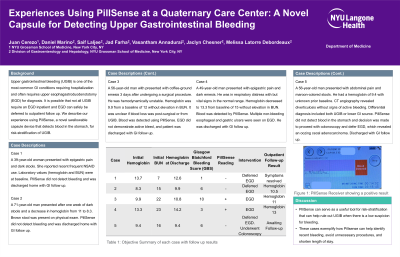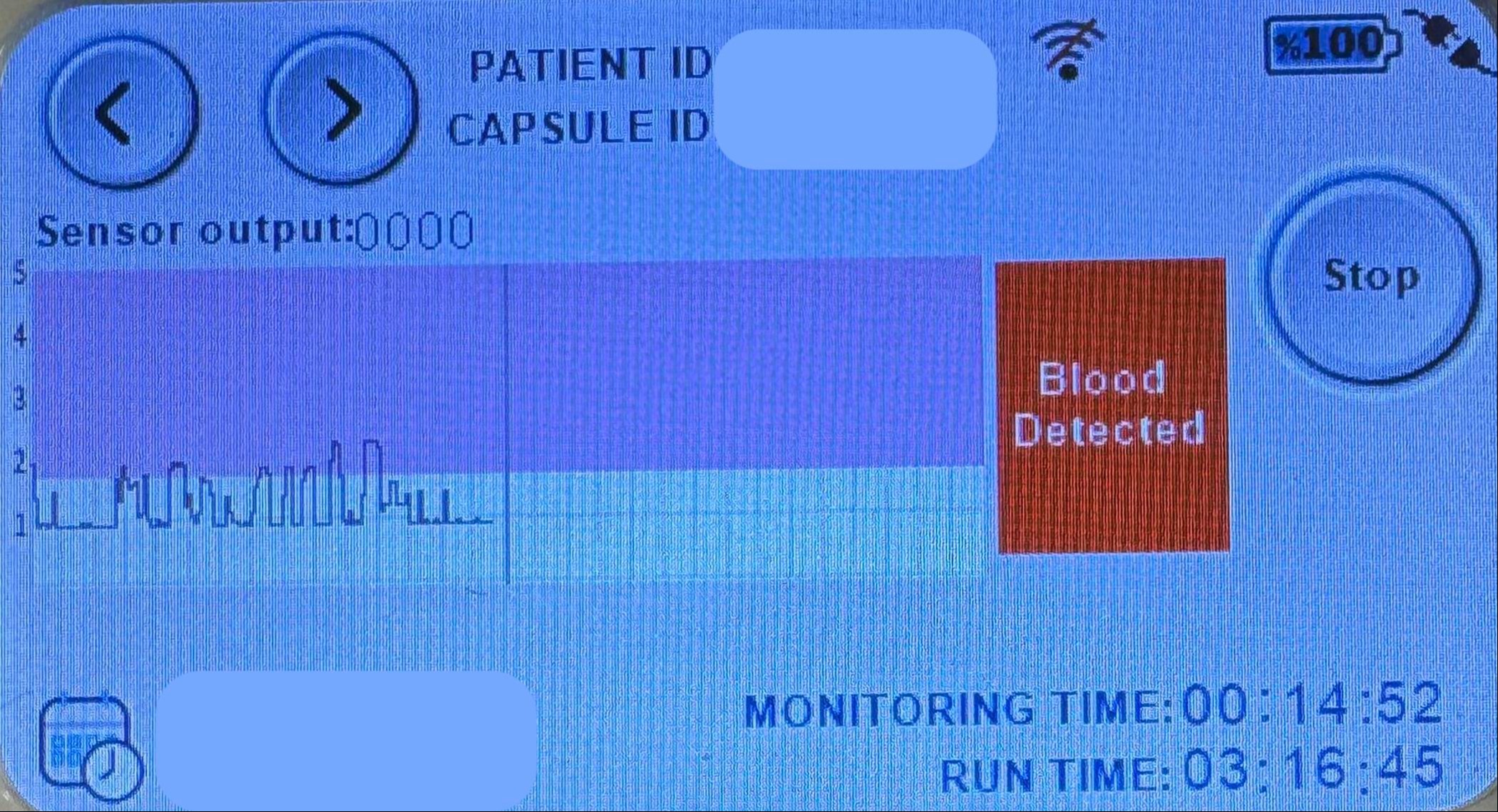Sunday Poster Session
Category: GI Bleeding
P0822 - Experiences Using PillSense at a Quaternary Care Center: A Novel Capsule for Detecting Upper Gastrointestinal Bleeding
Sunday, October 27, 2024
3:30 PM - 7:00 PM ET
Location: Exhibit Hall E

Has Audio

Juan Cerezo, MD
NYU Grossman School of Medicine
New York, NY
Presenting Author(s)
Juan Cerezo, MD1, Daniel Marino, MD, MBA2, Saif Laljee, MD2, Jad Farha, MD2, Vasantham Annadurai, MD2, Jaclyn Chesner, MD2, Melissa Latorre Debordeaux, MD2
1NYU Grossman School of Medicine, New York, NY; 2NYU Langone Health, New York, NY
Introduction: Upper gastrointestinal bleeding (UGIB) is one of the most common GI conditions requiring hospitalization and often requires upper esophagastroduodenotstomy (EGD) for diagnosis. It is possible that not all UGIB require an EGD inpatient and EGD can safely be deferred to outpatient follow up. We describe our experience using PillSense, a novel swallowable capsule device that detects blood in the stomach, for risk-stratification of UGIB.
Case Description/Methods: Case 1
A 39-year-old woman presented with epigastric pain and dark stools. She reported recent frequent NSAID use. Laboratory values (hemoglobin and BUN) were at baseline. PillSense did not detect bleeding and was discharged home with GI follow up.
Case 2
A 71-year-old man presented after one week of dark stools and a decrease in hemoglobin from 11 to 8.3. Brown stool was present on physical exam. PillSense did not detect bleeding and was discharged home with GI follow up.
Case 3
A 56-year-old man with presented with coffee-ground emesis 3 days after undergoing a surgical procedure. He was hemodynamically unstable. Hemoglobin was 9.9 from a baseline of 12 without elevation in BUN. It was unclear if blood loss was post-surgical or from UGIB. Blood was detected using PillSense. EGD did not demonstrate active bleeding and patient was discharged with GI follow up.
Case 4
A 49-year-old man presented with epigastric pain and dark emesis. He was in respiratory distress with but vital signs in the normal range. Hemoglobin decreased to 13.3 from baseline of 15 without elevation in BUN. Blood was detected by PillSense. Multiple non-bleeding esophageal and gastric ulcers were seen on EGD. He was discharged with GI follow up.
Case 5
A 56-year-old man presented with abdominal pain and maroon-colored stools. He had a hemoglobin of 9.4 with unknown prior baseline. CT angiography revealed diverticulosis without signs of active bleeding. Differential diagnosis included both UGIB or lower GI source. PillSense did not detect blood in the stomach and decision was made to proceed with colonoscopy and defer EGD, which revealed an oozing cecal adenocarcinoma. Discharged with GI follow up.
Table 1 shows an objective summary of each case.
Discussion: PillSense can serve as a useful tool for risk-stratification that can help rule out UGIB when there is a low suspicion for bleeding. These cases exemplify how Pillsense can help identify recent bleeding, avoid unnecessary procedures, and shorten length of stay.

Note: The table for this abstract can be viewed in the ePoster Gallery section of the ACG 2024 ePoster Site or in The American Journal of Gastroenterology's abstract supplement issue, both of which will be available starting October 27, 2024.
Disclosures:
Juan Cerezo, MD1, Daniel Marino, MD, MBA2, Saif Laljee, MD2, Jad Farha, MD2, Vasantham Annadurai, MD2, Jaclyn Chesner, MD2, Melissa Latorre Debordeaux, MD2. P0822 - Experiences Using PillSense at a Quaternary Care Center: A Novel Capsule for Detecting Upper Gastrointestinal Bleeding, ACG 2024 Annual Scientific Meeting Abstracts. Philadelphia, PA: American College of Gastroenterology.
1NYU Grossman School of Medicine, New York, NY; 2NYU Langone Health, New York, NY
Introduction: Upper gastrointestinal bleeding (UGIB) is one of the most common GI conditions requiring hospitalization and often requires upper esophagastroduodenotstomy (EGD) for diagnosis. It is possible that not all UGIB require an EGD inpatient and EGD can safely be deferred to outpatient follow up. We describe our experience using PillSense, a novel swallowable capsule device that detects blood in the stomach, for risk-stratification of UGIB.
Case Description/Methods: Case 1
A 39-year-old woman presented with epigastric pain and dark stools. She reported recent frequent NSAID use. Laboratory values (hemoglobin and BUN) were at baseline. PillSense did not detect bleeding and was discharged home with GI follow up.
Case 2
A 71-year-old man presented after one week of dark stools and a decrease in hemoglobin from 11 to 8.3. Brown stool was present on physical exam. PillSense did not detect bleeding and was discharged home with GI follow up.
Case 3
A 56-year-old man with presented with coffee-ground emesis 3 days after undergoing a surgical procedure. He was hemodynamically unstable. Hemoglobin was 9.9 from a baseline of 12 without elevation in BUN. It was unclear if blood loss was post-surgical or from UGIB. Blood was detected using PillSense. EGD did not demonstrate active bleeding and patient was discharged with GI follow up.
Case 4
A 49-year-old man presented with epigastric pain and dark emesis. He was in respiratory distress with but vital signs in the normal range. Hemoglobin decreased to 13.3 from baseline of 15 without elevation in BUN. Blood was detected by PillSense. Multiple non-bleeding esophageal and gastric ulcers were seen on EGD. He was discharged with GI follow up.
Case 5
A 56-year-old man presented with abdominal pain and maroon-colored stools. He had a hemoglobin of 9.4 with unknown prior baseline. CT angiography revealed diverticulosis without signs of active bleeding. Differential diagnosis included both UGIB or lower GI source. PillSense did not detect blood in the stomach and decision was made to proceed with colonoscopy and defer EGD, which revealed an oozing cecal adenocarcinoma. Discharged with GI follow up.
Table 1 shows an objective summary of each case.
Discussion: PillSense can serve as a useful tool for risk-stratification that can help rule out UGIB when there is a low suspicion for bleeding. These cases exemplify how Pillsense can help identify recent bleeding, avoid unnecessary procedures, and shorten length of stay.

Figure: Figure 1: PillSense receiver showing a positive result.
Note: The table for this abstract can be viewed in the ePoster Gallery section of the ACG 2024 ePoster Site or in The American Journal of Gastroenterology's abstract supplement issue, both of which will be available starting October 27, 2024.
Disclosures:
Juan Cerezo indicated no relevant financial relationships.
Daniel Marino indicated no relevant financial relationships.
Saif Laljee indicated no relevant financial relationships.
Jad Farha indicated no relevant financial relationships.
Vasantham Annadurai indicated no relevant financial relationships.
Jaclyn Chesner indicated no relevant financial relationships.
Melissa Latorre Debordeaux: Enterasense – Consultant. Medtronic – Consultant. Motus GI – Consultant. Olympus – Consultant. OVESCO – Consultant. VTI – Consultant.
Juan Cerezo, MD1, Daniel Marino, MD, MBA2, Saif Laljee, MD2, Jad Farha, MD2, Vasantham Annadurai, MD2, Jaclyn Chesner, MD2, Melissa Latorre Debordeaux, MD2. P0822 - Experiences Using PillSense at a Quaternary Care Center: A Novel Capsule for Detecting Upper Gastrointestinal Bleeding, ACG 2024 Annual Scientific Meeting Abstracts. Philadelphia, PA: American College of Gastroenterology.
